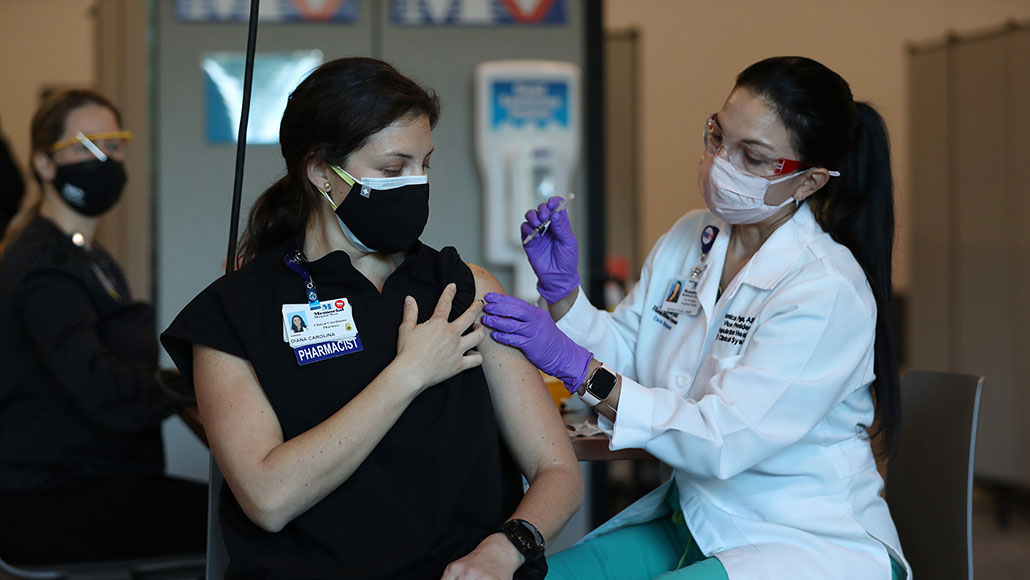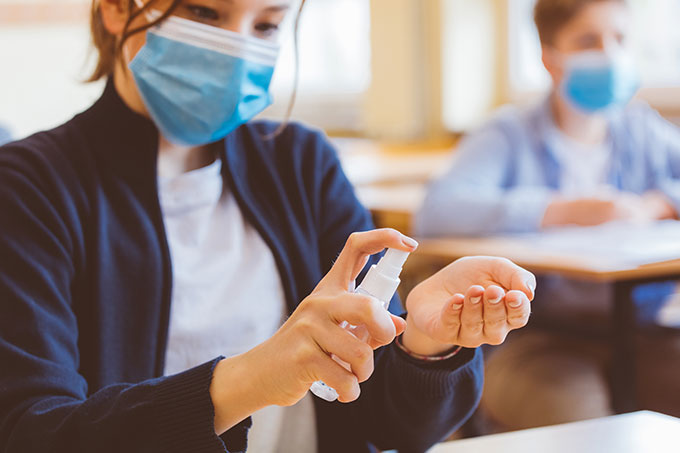Moderna and Pfizer vaccines appear to cut coronavirus spread
Fully vaccinated people seem to pose very low risk of spreading infection, studies show

Pharmacist Diana Carolina at Memorial Healthcare System gets her first dose of a COVID-19 vaccine. Studies in health-care workers indicate these shots reduce the risk of catching the new coronavirus.
Joe Raedle/Staff/Getty Images News
Several vaccines against COVID-19 are good at keeping people from getting sick with COVID-19. But it wasn’t known if these vaccines could also stop people from being infected in the first place. That’s because previous studies had looked only at whether people got symptoms. Now several studies have also examined whether vaccinated people with no symptoms carry the virus. New data from these studies suggest some vaccines indeed can prevent the virus from infecting most immunized people.
The encouraging finding comes from real-world studies. They involved health-care workers, firefighters, police, teachers and other essential workers.
SARS-CoV-2 is the virus that causes COVID-19. For full immunization, people receive two shots of the mRNA vaccines made by Pfizer and Moderna. But even getting just one shot cut the chance of becoming infected. Researchers shared that news March 29 in Morbidity and Mortality Weekly Report (MMWR).
“We clearly showed . . . if you were at least 14 days out from your first shot, you had 80 percent protection” from infection, says Jeff Burgess. It bumps up to 90 percent protection after the second shot. Burgess is the associate dean for research at the University of Arizona’s College of Public Health in Tucson. His team’s study is part of a growing body of data showing vaccines can prevent catching SARS-CoV-2.
“If you can’t get infected, you can’t infect anyone else,” says Marm Kilpatrick, who was not involved in the study. This means the vaccines can reduce spread of the virus, he says. Kilpatrick works at the University of California, Santa Cruz. There he studies infectious diseases.
In recent weeks, U.S. coronavirus cases, hospital admissions and deaths have been on the rise. The uptick in all of these measures followed a move by many states to lift mask mandates. Many states also opened businesses to full capacity.
“Right now I’m scared,” says Rochelle Walensky. She’s the new director of the U.S. Centers for Disease Control and Prevention. It’s based in Atlanta, Ga. During a White House briefing on March 29, she noted a “feeling I have of impending doom.” To head off a potential fourth surge of the disease, she urged people to continue to wear masks. She also asked them to get vaccinated and to not stop social distancing. “We have so much to look forward to,” she said, “and so much reason for hope.”
Among new reasons for hope: Vaccines may help stop the spread of the coronavirus in adults. And vaccines seem to work well in kids, too.
COVID-19 vaccines work for kids
Pfizer-BioNTech has just shared the first data on its vaccine’s testing in 12- to 15-year olds. In a trial, 18 adolescents got COVID-19. All of those cases were in the group of 1,129 kids who got a placebo shot, according to a March 31 news release. A placebo looks similar to a real drug or vaccine. It doesn’t, however, actually have any medicine or vaccine in it. Of the 1,131 teens who got a vaccine shot, none got sick. Those data suggest the vaccine could be 100 percent effective in young adolescents.
But the study was small. As more kids get vaccinated, scientists will get a better picture of how well the vaccines work in the real world.
A subset of the vaccinated kids were looked at more closely. Within a month of their second shot, they had developed a lot of neutralizing antibodies. That points to a strong immune response. In fact, their responses were better than those seen in 16- to 25-year olds.
Last week, the trial expanded to begin shots in kids as young as 6 months old. So data on the vaccine’s effectiveness in younger kids are expected soon. Moderna has also begun testing its vaccine on young children.
So far, these new Pfizer data in young adolescents have not been peer reviewed. So outside experts have not had a chance to look for any signs of problems in how the study was designed or its data analyzed. The U.S. Food and Drug Administration also has not approved any of the COVID-19 vaccines yet for kids this age. But that may change soon. Pfizer says it plans to ask FDA for an emergency-use approval to vaccinate kids 12 and up.
Real-world studies
The Pfizer study in kids is a clinical trial. Clinical trials test something in thousands of people to get an idea of how well it works. But sometimes scientists find different results when millions of people take a new treatment. That’s why the new data from real-world studies are so encouraging. They suggest the mRNA vaccines are truly as effective at preventing illness as the clinical trials had suggested. These vaccines have the added benefit of stopping infections, several new studies suggest.
CDC researchers led the new MMWR study. They followed nearly 4,000 health-care and other essential workers in six states. From December 14 through March 13, each recruit submitted weekly nasal swabs. These were tested for signs of the coronavirus. Rates of infections — with or without symptoms — were lower in those who were vaccinated.
Real-world data collected from two other studies of health-care workers seem to back these findings. Both were published March 23 in the New England Journal of Medicine.
One looked at employees at the University of Texas Southwestern Medical Center in Dallas. It took place between December 15 and January 28. Of 8,969 people who had not been vaccinated, 34 tested positive for the coronavirus. That’s 2.61 percent. In contrast, of the 6,144 employees who had gotten one shot, just 1.82 percent tested positive. The infection rate was much smaller still — just 0.05 percent — among the 8,121 workers who had gotten both of their shots.
A second report looked at infections among health-care workers in California. Only seven infections occurred among 4,167 people who were at least 15 days out from getting their second dose of a vaccine. These shots kept health-care workers in the study from becoming seriously ill, notes study coauthor Francesca Torriani. She’s a physician at the University of California, San Diego. She works there as a hospital epidemiologist who studies infectious diseases.

Precautions still needed
Because some people can still get infected after those shots, the CDC and other health agencies recommend continuing to wear masks in public and to take other precautions.
And data from Israel suggest why. It found that unvaccinated people produce 2.58 to 4.5 times more virus than do those who got the Pfizer vaccine. The findings were reported March 29 in Nature Medicine. That lower “viral load” in vaccinated people means they will be less likely to spread the virus, Kilpatrick says. That drop in virus levels amounts to about an 11 percent drop in infectiousness, he points out. While “that’s good,” he adds, you’d really prefer to drop that infectiousness by at least half to three-quarters.
Torriani would also like to see data from everyday citizens. Except for the MMWR study, almost all U.S. real-world vaccine data come from health-care workers. And they may not give a true picture of risks, she points out. Health-care workers tend to have get better personal protective gear and ventilation than do most members of the public. She would like to see whether people who get their shots are less likely to infect household members. “If [household transmission] goes away with vaccination,” she says, “that would be the proof.”